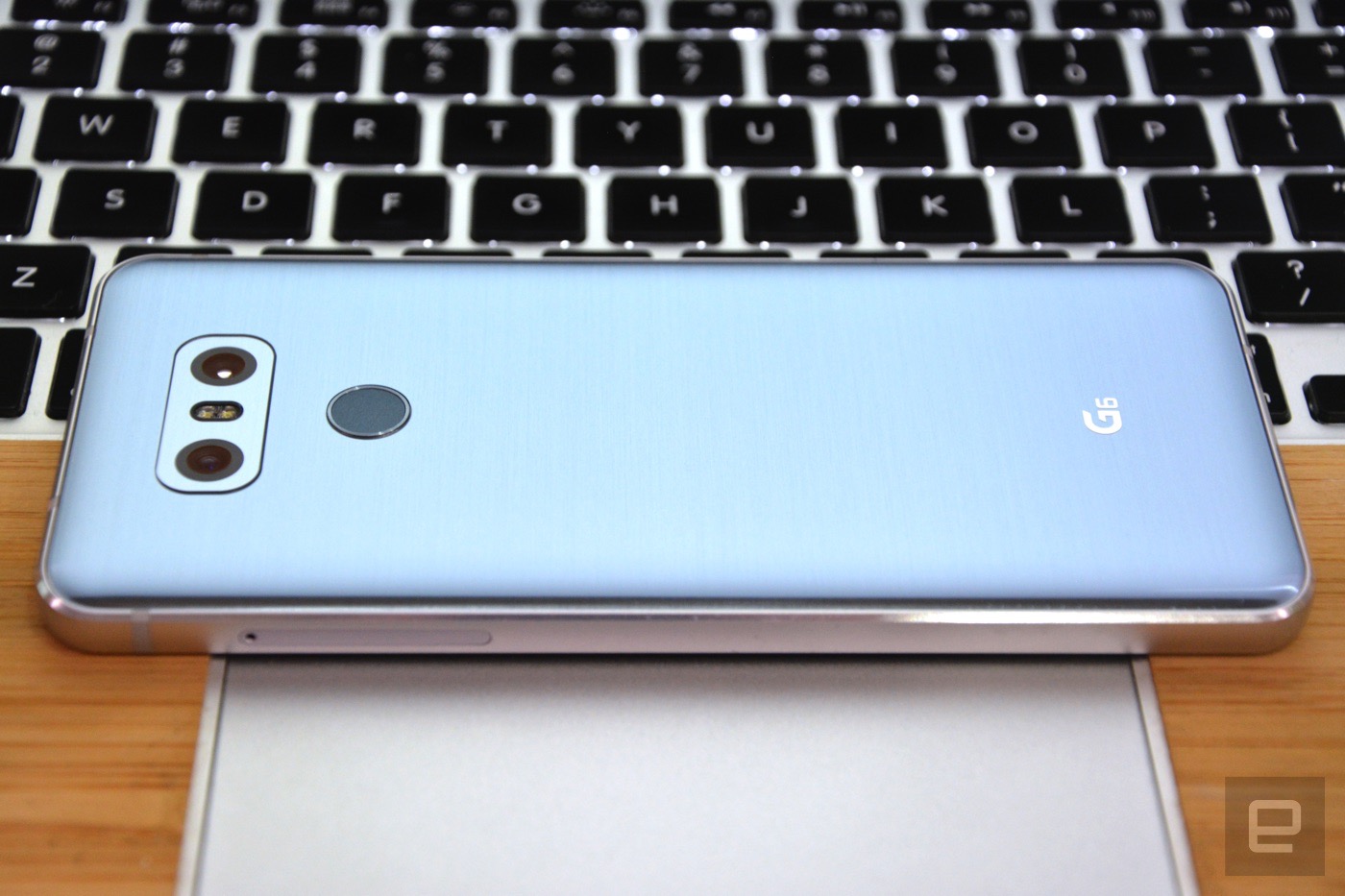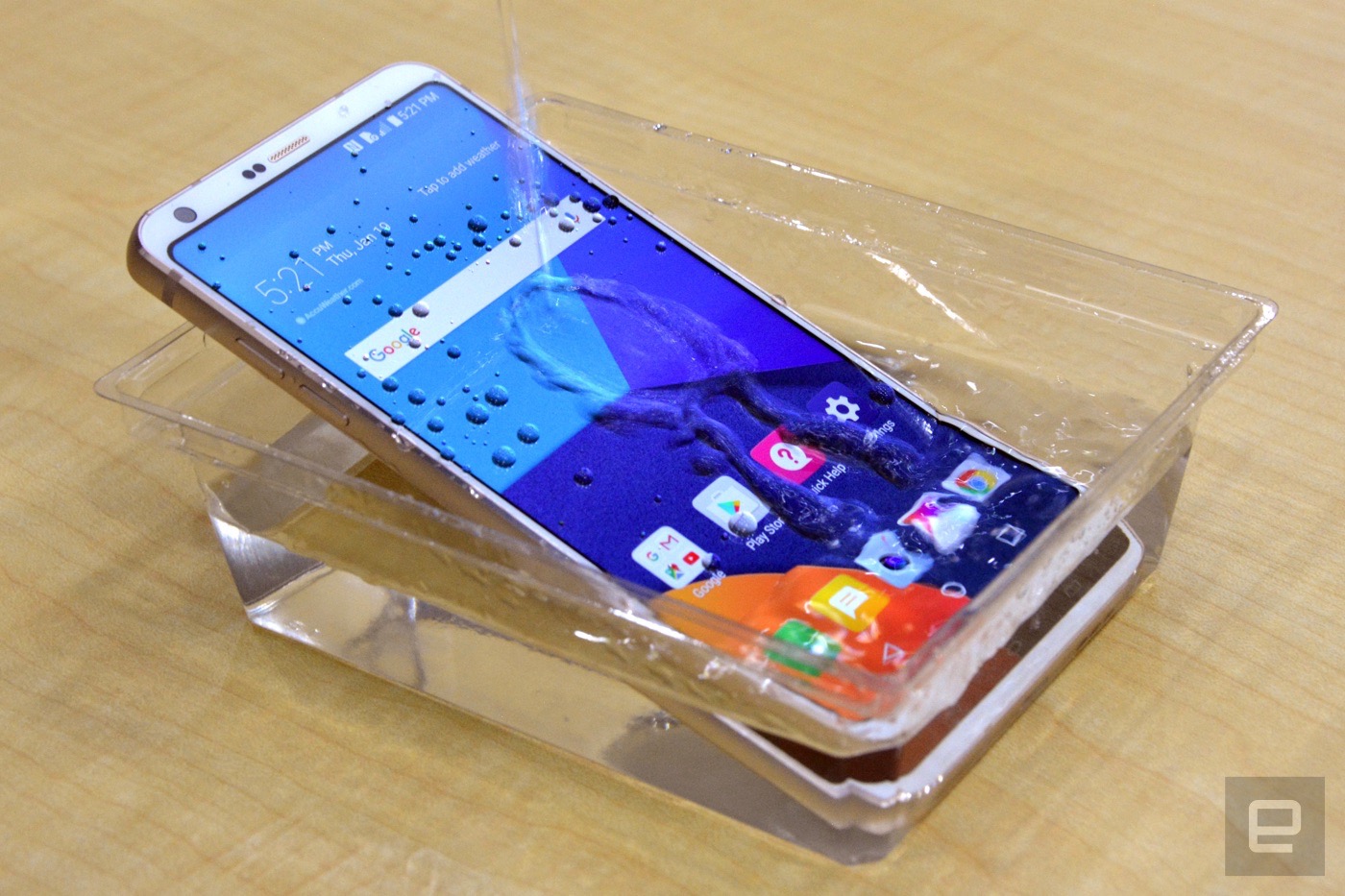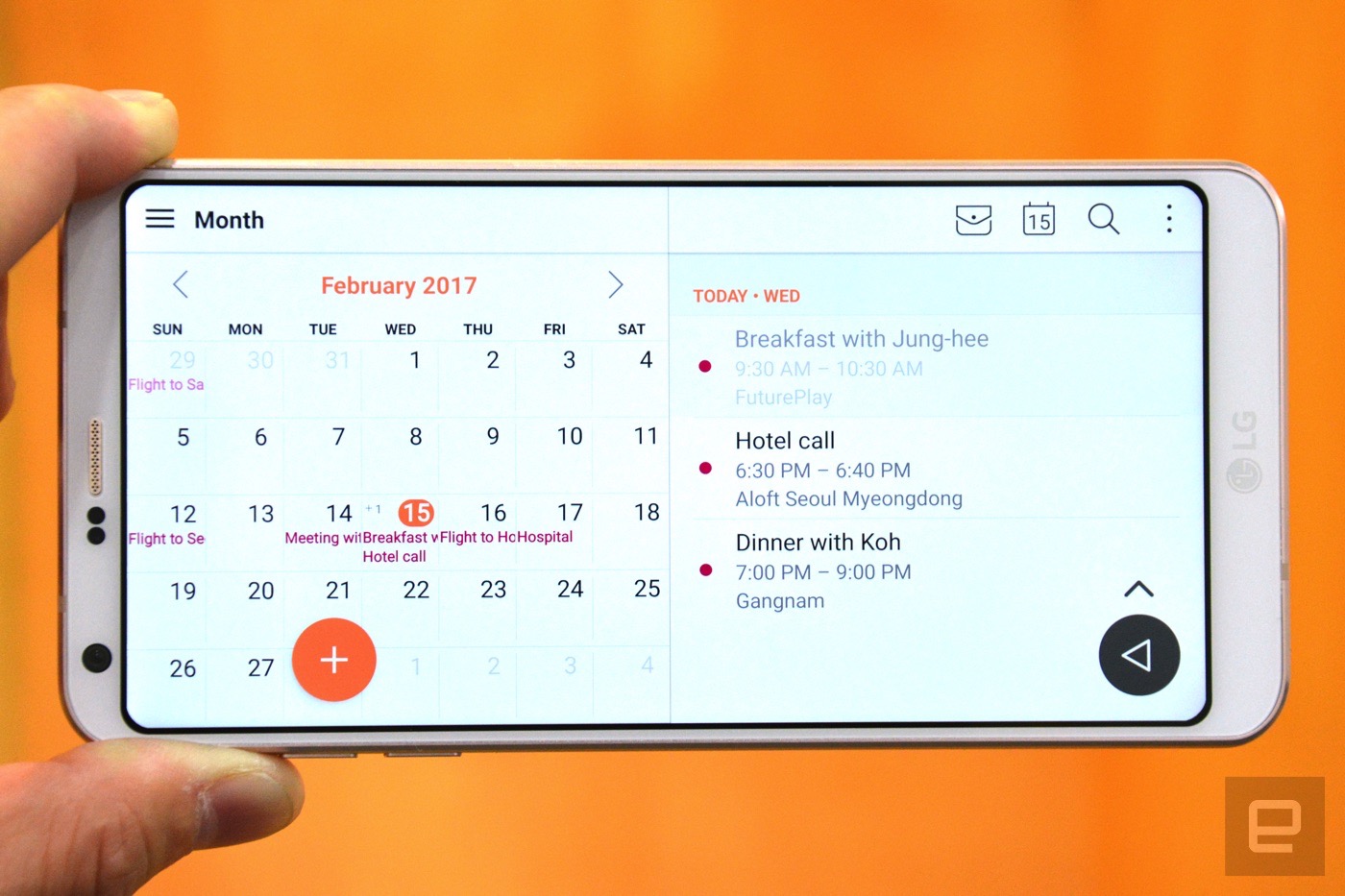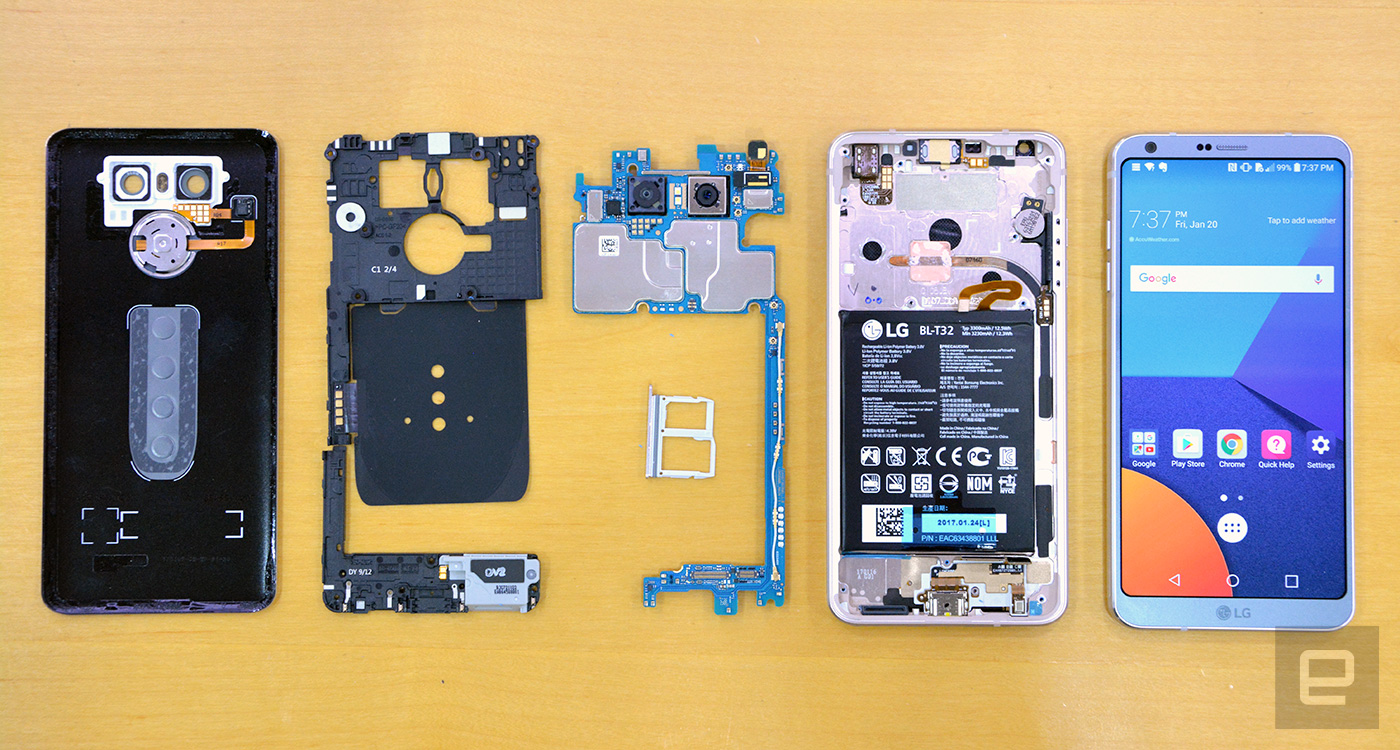Upon seeing the G6 for the first time, I was impressed by how much cleaner and more premium it looked than its predecessor. What used to be a metallic back is now a shiny slab of Gorilla Glass 5, which gently curves down to meet a smooth aluminum frame on all sides. You’ll spot LG’s signature setup of a dual-camera module plus fingerprint reader, but unlike on the G5, these are now flush with the back plate. LG mainly achieved this by using slimmer camera sensors, but more on that later. The launch colors are “Ice Platinum” (like Samsung’s “Coral Blue” but with brushed metal finish under glass, silver frame), “Astro Black” (black glass, space grey frame) and “Mystic White” (white glass, champagne gold frame), with more options to follow in the future.

On the front, the 5.7-inch IPS screen packs a resolution of 2,880 x 1,440, along with a pixel density of 564 ppi plus support for Dolby Vision and HDR10 content. That panel is covered by a flat sheet of Gorilla Glass 3 which sits flush with the metallic frame — a design choice made to protect the display from scratches and drops. Despite the taller screen, its reduced bezel along the top and bottom sides has enabled a smaller body footprint than, say, the G5, S7 Edge and OnePlus 3T, thus letting the G6 fit a tad more comfortably in one’s hand.
Another notable feature here is that the display panel has rounded corners, a decision made for both aesthetic reasons and to offer better protection against corner drops — LG’s data claims a rounded corner allows for stress dispersion upon impact, as opposed to a sharp corner taking the full blow.
In terms of core specs, the G6 is largely on par with other recent flagships. It runs Android 7.0 (pre-loaded with Google Assistant) and packs a Qualcomm Snapdragon 821 chipset (MSM8996AC), 4GB of LPDDR4 RAM, 32GB of UFS 2.0 storage, microSD expansion, dual microphones, USB 3.1, NFC and LTE downlink of up to 600 Mbps. The surprise here is that the G6 has a dustproof and waterproof rating of IP68, meaning it’s completely protected against dust ingression, and has been tested for continuous immersion under at least one meter of water. (Amazingly, LG said it tested its phone in salt water as well.) As such, the Nano SIM + microSD tray is the only removable part, and it uses a rubber gasket to seal properly.

For some, the trade-off here is that the battery is no longer removable, but you do get a much larger 3,300 mAh lithium polymer cell. With the bundled Quick Charge 3.0 power adapter and USB-C cable, I managed to go from a depleted battery to 34 percent charge in just half an hour, and then to full charge 72 minutes after that. But it isn’t just about a larger battery this time. Following the Note 7 fiasco, LG began testing batteries at higher voltages and with more recharging cycles as well. And, just to be safe, it also increased the thickness of the separators inside the G6’s battery, so that it’s better protected against short circuiting due to external forces.
On a recent trip to LG’s factory in Korea, the lab technicians proved their batteries’ durability by showing me a couple of crazy torture tests. The first one threw a thick steel rod right onto a fully-charged G6 battery right in front of me but nothing happened, whereas a non-LG battery blew up in the same test, but that was only shown in a video for safety reasons. The second test was rather painful to watch: An apparatus slowly pushed a large needle into another fully-charged G6 battery, but again, no boom. And yes, I also watched a video of a non-LG battery quickly exploding in the same test.
LG has a flame test as well, which the battery can supposedly withstand, but I didn’t have the opportunity to observe it in action. Just to be doubly safe, LG added a heat pipe to help lower the chipset’s heat, and it seemed to do its job well during my 20-minute N.O.V.A. 3 gameplay.

Now, this is where things get a little confusing: Some of G6’s special features will only be available in select markets. For instance, built-in wireless charging is only available on the US models, whereas the 32-bit Quad DAC previously seen on the V20 is only available in the Asian variants — bad news for audiophiles elsewhere in the world. Similarly, only some Asian markets will offer a 64GB model as well as a dual-SIM variant. Simply put, you won’t find a “perfect” model anywhere, which is a real shame.
On the software side, LG’s new “UX 6.0” takes full advantage of the G6’s 18:9 screen aspect ratio. Many of its native apps — namely Gallery, Contacts, Calendar, E-mail and Music — are designed with a dual-square grid in mind, making them more practical and aesthetically pleasing, to boot. The same applies to Android 7.0’s multi-window view, in which you can set a square window for both apps if you want. The feature-packed Camera app goes even further by offering a scrollable thumbnail bar, so that you don’t have to go into the gallery to browse recent photos.
Most of the major third-party apps I tried rendered just fine on the G6’s taller screen; the issues I came across were relatively minor and should be easy to fix. For example, the top bar in the Facebook app would double in height after a while for some reason. Then in Netflix and VLC, the full-screen videos were forced to one side as the hidden Android navigation bar left a blank space behind. YouTube and the native video player don’t have this problem, but only the latter offers a “zoom” mode to enable a true full-screen playback.

In case you’re wondering, yes, the G6 is intentionally skipping the Snapdragon 835, and for good reason. LG’s product planning team pointed out that due to the chip’s new 10nm process plus additional circuitry, it would take some time before production quality reaches a satisfactory level, and that’s on top of the time needed for LG to test the chip for the sake of reliability. Even though LG never said as much on record, it’s clear that it wants to beat Samsung’s Galaxy S8 to market by a wide margin, so it makes sense to stick with a chip that’s a known entity.
But not all is lost, as LG worked with Qualcomm to port the Snapdragon 835’s camera zoom transition feature to the G6 for both stills and video. This enables a smoother switch between the two cameras while zooming, and indeed, the switch delay is less noticeable than what I’ve seen on the iPhone 7 Plus.
Speaking of, the G6’s dual-camera module is powered by Sony’s 13-megapixel IMX258, with the f/1.8 main camera featuring optical stabilization plus a 71-degree field of view, and the f/2.4 wide camera looking at 125 degrees. On the other side, the 5-megapixel selfie camera has an f/2.2 aperture and 100-degree field of view. As with the G5 and the G4, LG is still sticking with the 1.12um pixel size for all three sensors, but the lower resolutions are inevitable given LG’s insistence on removing the camera bump. What’s more concerning is the lack of laser autofocus and color spectrum sensor this time, but LG believes its software optimization makes up for it. We shall see.

Based on my brief experience with the G6 so far, it’s safe to say that LG has taken a sensible approach. Here we have a solid device that’s tougher, more practical and better-looking than its predecessor, and its FullVision display is a much-welcome feature in a market where phones tend to struggle to stand out. It can perhaps be a little frustrating knowing that no matter where you get your G6 from, you’re still missing out on certain features, so it’ll be interesting to see how the consumers respond when the regional prices come out. There’s no word on availability yet, so until then, we’ll continue to fiddle with our G6 and let you know how we get on with it.
Click here to catch up on the latest news from MWC 2017.





